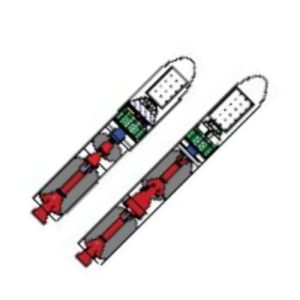
Home - Search - Browse - Alphabetic Index: 0- 1- 2- 3- 4- 5- 6- 7- 8- 9
A- B- C- D- E- F- G- H- I- J- K- L- M- N- O- P- Q- R- S- T- U- V- W- X- Y- Z
Eaglet
 Eaglet Credit: Department of Commerce |
AKA: Eagle S-Series;Peacekeeper. Status: Study 2001-2006. Payload: 580 kg (1,270 lb). Height: 13.00 m (42.00 ft). Diameter: 2.34 m (7.67 ft). Span: 4.00 m (13.10 ft). Apogee: 185 km (114 mi).
E'Prime also proposed larger vehicles, designated S-1 through S-7, with the ability to place considerably larger payloads into LEO and to add a geosynchronous Earth orbit (GEO) capability. The Eagle S-series concept dated back to 1987 when the company signed a commercialization agreement with the USAF to use Peacekeeper technology for commercial launch vehicles. Like the Peacekeeper, this vehicle would be ejected from a ground-based silo, using a compressed gas system. At an altitude of 61 meters the vehicle's engines would ignite.
E'Prime signed an agreement with NASA in February 2001 that gave the company use of available property and services on a non-interference basis. For equatorial orbits, the company planned to launch the Eaglet and Eagle, and the company's entire canister launch program from facilities at NASA KSC that the company had yet to construct. Plans to launch from Virginia Space Flight Center for equatorial orbits and from the Kodiak Launch Complex for polar orbits were also under consideration. In 2004, the company entered into a partnership with the Savannah River National Laboratory to develop technologies for the Eagle S-series of launch vehicles and related systems.
The availability of decommissioned Peacekeeper rocket motors, to be used for space launch under such concepts as OCS's Minotaur IV/V, put the feasibility of the Eagle into doubt.
LEO Payload: 580 kg (1,270 lb) to a 185 km orbit at 28.00 degrees. Development Cost $: 700.000 million. Launch Price $: 1.000 million in 2002 dollars in 2002 dollars. Boost Propulsion: Lox/LH2.
Family: all-solid, orbital launch vehicle. Country: USA. Agency: E'Prime Aerospace.
Back to top of page
Home - Search - Browse - Alphabetic Index: 0- 1- 2- 3- 4- 5- 6- 7- 8- 9
A- B- C- D- E- F- G- H- I- J- K- L- M- N- O- P- Q- R- S- T- U- V- W- X- Y- Z
© 1997-2019 Mark Wade - Contact
© / Conditions for Use